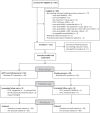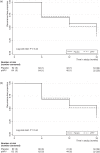HPV vaccination to prevent recurrence of anal intraepithelial neoplasia in HIV+ MSM
- PMID: 33966029
- PMCID: PMC8373452
- DOI: 10.1097/QAD.0000000000002928
HPV vaccination to prevent recurrence of anal intraepithelial neoplasia in HIV+ MSM
Abstract
Objective: Anal cancer precursor lesions high-grade anal intraepithelial neoplasia (HGAIN) are highly prevalent among HIV+ MSM. Treatment of HGAIN is frustrated by high recurrence rates. We investigated the efficacy of the quadrivalent human papillomavirus (qHPV) vaccine as posttreatment adjuvant in preventing HGAIN recurrence in HIV+ MSM.
Design: Randomized, double-blind, placebo-controlled, multicentre trial.
Setting: Three HIV outpatient clinics in Amsterdam, the Netherlands.
Subjects: HIV+ MSM with CD4+ cell count more than 350 cells/μl, biopsy-proven intra-anal HGAIN successfully treated in the past year, and lesions still in remission at enrolment, as assessed by high-resolution anoscopy (HRA).
Intervention: Participants were randomized to three doses of qHPV (Gardasil-4, MSD) or placebo with vaccinations at 0, 2, and 6 months. HRA was repeated at 6, 12, and 18 months.
Main outcome measure: The primary outcome was cumulative, biopsy-proven HGAIN recurrence rate at 18 months, evaluated in an intention-to-treat (ITT) (received all vaccinations) and per-protocol analysis (all vaccinations and complete follow-up).
Results: We randomized 126 participants of which 64 (50.8%) received qHPV and 62 (49.2%) placebo. All participants received three vaccinations, and in both groups for two participants follow-up was incomplete. We found no difference (P = 0.38) in cumulative HGAIN recurrence rates between the qHPV (44/64, 68.8%) and placebo group (38/62, 61.3%) in the ITT analysis [absolute risk reduction -7.5 (95% confidence interval (CI) -24.1 to 9.2)]. This was similar in the per-protocol analysis.
Conclusion: Despite adequate serological responses to qHPV vaccination, short-term recurrence of HGAIN was not prevented. These findings do not support qHPV vaccination as a treatment adjuvant to prevent HGAIN recurrence in HIV+ MSM.
Copyright © 2021 The Author(s). Published by Wolters Kluwer Health, Inc.
Conflict of interest statement
M.G.W.D. has a family member working at MSD. H.J.C.d.V. received money or goods for research from Medigene, Gilead and MSD, money for presentations from Abbott and Janssen and money for advice from Medigene and Novartis. All other authors have no conflicts of interest to declare.
Figures
Comment in
-
Anal neoplasia: prevention or treatment?AIDS. 2021 Sep 1;35(11):1863-1865. doi: 10.1097/QAD.0000000000002969. AIDS. 2021. PMID: 34397485 No abstract available.
Similar articles
-
Clinical effectiveness and cost-effectiveness of quadrivalent human papillomavirus vaccination in HIV-negative men who have sex with men to prevent recurrent high-grade anal intraepithelial neoplasia.Vaccine. 2014 Dec 5;32(51):6941-6947. doi: 10.1016/j.vaccine.2014.10.052. Epub 2014 Nov 1. Vaccine. 2014. PMID: 25444820 Free PMC article.
-
Prevention of recurrent high-grade anal neoplasia with quadrivalent human papillomavirus vaccination of men who have sex with men: a nonconcurrent cohort study.Clin Infect Dis. 2012 Apr;54(7):891-8. doi: 10.1093/cid/cir1036. Epub 2012 Jan 30. Clin Infect Dis. 2012. PMID: 22291111
-
Long-Term Outcomes of Adding HPV Vaccine to the Anal Intraepithelial Neoplasia Treatment Regimen in HIV-Positive Men Who Have Sex With Men.Clin Infect Dis. 2015 Nov 15;61(10):1527-35. doi: 10.1093/cid/civ628. Epub 2015 Jul 29. Clin Infect Dis. 2015. PMID: 26223993 Free PMC article.
-
HPV and anal cancer in HIV-infected individuals: a review.Curr HIV/AIDS Rep. 2014 Sep;11(3):250-62. doi: 10.1007/s11904-014-0224-x. Curr HIV/AIDS Rep. 2014. PMID: 24990810 Review.
-
Human papillomavirus and anal neoplasia.Curr HIV/AIDS Rep. 2008 May;5(2):78-85. doi: 10.1007/s11904-008-0013-5. Curr HIV/AIDS Rep. 2008. PMID: 18510893 Review.
Cited by
-
DNA Methylation Analysis to predict Regression of high-grade anal Intraepithelial Neoplasia in HIV+ men (MARINE): a cohort study protocol.BMJ Open. 2022 Aug 3;12(8):e060301. doi: 10.1136/bmjopen-2021-060301. BMJ Open. 2022. PMID: 35922105 Free PMC article.
-
Interventions for anal canal intraepithelial neoplasia.Cochrane Database Syst Rev. 2025 Aug 13;8(8):CD009244. doi: 10.1002/14651858.CD009244.pub3. Cochrane Database Syst Rev. 2025. PMID: 40801169 Review.
-
Update on the Epidemiological Features and Clinical Implications of Human Papillomavirus Infection (HPV) and Human Immunodeficiency Virus (HIV) Coinfection.Microorganisms. 2022 May 18;10(5):1047. doi: 10.3390/microorganisms10051047. Microorganisms. 2022. PMID: 35630489 Free PMC article. Review.
-
Cervical cancer prevention and control in women living with human immunodeficiency virus.CA Cancer J Clin. 2021 Nov;71(6):505-526. doi: 10.3322/caac.21696. Epub 2021 Sep 9. CA Cancer J Clin. 2021. PMID: 34499351 Free PMC article. Review.
-
Timing of HPV vaccination as adjuvant treatment of CIN2+ recurrence in women undergoing surgical excision: a meta-analysis and meta-regression.Sex Transm Infect. 2023 Dec;99(8):561-570. doi: 10.1136/sextrans-2023-055793. Epub 2023 Aug 8. Sex Transm Infect. 2023. PMID: 37553234 Free PMC article.
References
-
- Hoots BE, Palefsky JM, Pimenta JM, Smith JS. Human papillomavirus type distribution in anal cancer and anal intraepithelial lesions. Int J Cancer 2009; 124:2375–2383. - PubMed
-
- Moody CA, Laimins LA. Human papillomavirus oncoproteins: pathways to transformation. Nat Rev Cancer 2010; 10:550–560. - PubMed
-
- Machalek DA, Poynten M, Jin F, Fairley CK, Farnsworth A, Garland SM, et al. . Anal human papillomavirus infection and associated neoplastic lesions in men who have sex with men: a systematic review and meta-analysis. Lancet Oncol 2012; 13:487–500. - PubMed
Publication types
MeSH terms
LinkOut - more resources
Full Text Sources
Other Literature Sources
Medical
Research Materials
Miscellaneous




